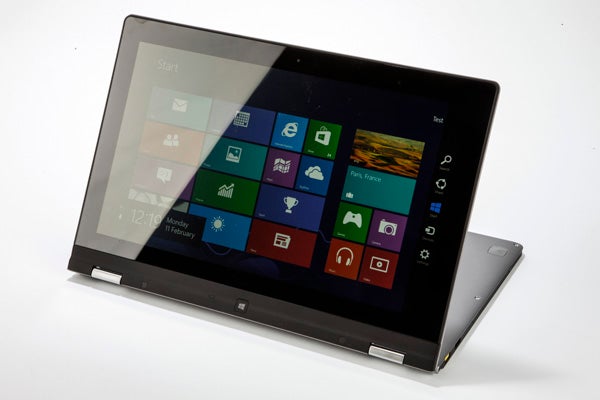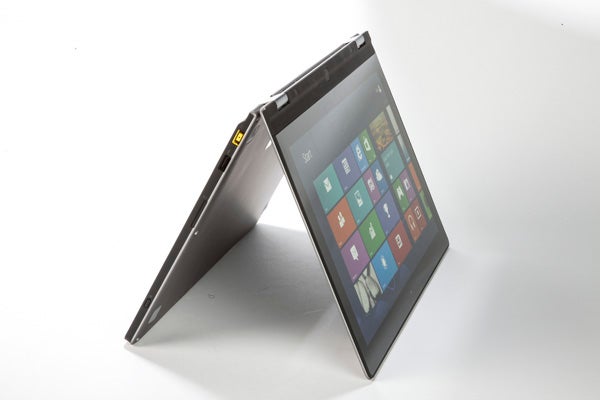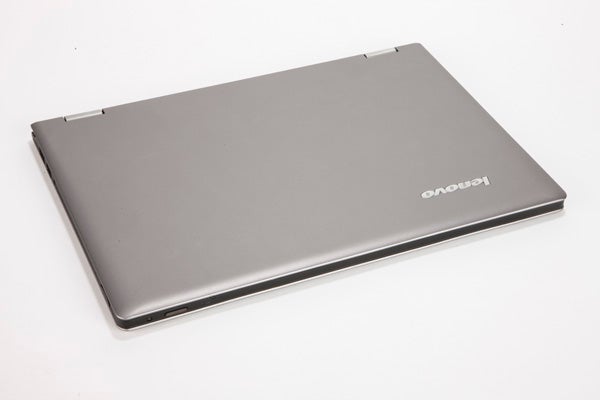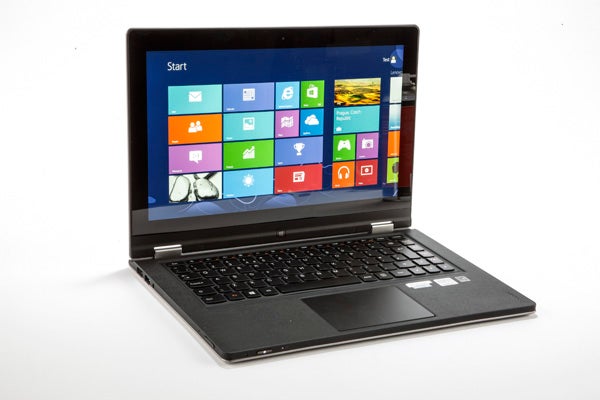Lenovo IdeaPad Yoga 13 Review
Lenovo IdeaPad Yoga 13
Is this flexible flip-screen convertible the ideal marriage of Ultrabook and tablet?

Sections
- Page 1 Lenovo IdeaPad Yoga 13 Review
- Page 2 Connectivity, Usability, Touch and Tablet Review
- Page 3 Screen, Speakers and Specs Review
- Page 4 Battery, Value and Verdict Review
Verdict
Pros
- Flexible body (it’s in the name)
- Soft-touch materials throughout
- Good screen
- Decent keyboard
- Stylish looks
Cons
- Heavy for a ‘tablet’
- No optional digitizer stylus
- Poor speakers
- Keyboard not up to highest Lenovo standards
Key Specifications
- Review Price: £999.00
- 13-inch 1600 x 900 IPS screen with 10-point touch
- Core i7 CPU, 4GB of RAM (up to 8GB), 128GB SSD (up to 256GB)
- Unique twist-round 360-degree hinge and soft-touch finish
Introduction
The 13-inch Lenovo Yoga was one of the first convertible Windows 8 tablet/laptops we saw, all the way back in early 2012 – if you don’t count the Lenovo Pocket Yoga from 2009, that is. Since its initial announcement, we’ve seen a smaller 11.6-inch Lenovo IdeaPad Yoga 11 (yes you guessed it, the final number refers to screen size), and even an ARM-based Lenovo Yoga running Windows RT on Tegra 3. However, today we’re checking out the full-fat 13-inch version, which has few rivals as the majority of convertible tablet laptops come in at 11.6 or 12.5 inches. 
Just in case you haven’t come across it before, the Lenovo IdeaPad Yoga 13 is essentially an Ultrabook whose screen/lid section flips around 180 degrees onto the back of its base to turn into a tablet. It’s a unique solution that leaves the keyboard facing out at the convertible’s rear in ‘tablet mode’.
Looking for other options? Check out our Best Windows 8 Laptops, Tablets, Convertibles and PCs roundup
Packed into its flexible chassis, the Lenovo Yoga 13 has some tasty specs: its 13-inch IPS screen may not offer a Full HD (1,920 x 1,080) resolution, but at 1,600 x 900 pixels it’s significantly higher than many affordable rivals and offers 10-finger touch. Under the hood, this Yoga can offer up to a Core i7 CPU, up to 8GB of RAM and a 256GB SSD, putting it at the top of the convertible game in terms of power – yet Lenovo still claims battery life of up to eight hours. All that’s lacking is pressure-sensitive stylus support, but as the Core i7 version comes in at under £1,000, that’s easy to forgive.
Lenovo IdeaPad Yoga 13 – Design and Build
As usual from Lenovo’s high-end machines, the 13-inch IdeaPad Yoga is beautifully designed. In fact, with a soft-touch outer ‘lining’ and textured soft matt black innards, its look is very reminiscent of the already attractive Lenovo IdeaPad U260, except more elegant and far slimmer at a mere 16.9mm. Though the Yoga’s insides remain black, the outside can be had in either a bronzed orange or silver grey, both of which look fantastic.
The soft-touch outer finish prevents fingerprints, feels great, and offers a superb grip, making this a very comfortable laptop to hold and carry. Thanks to its grippy outsides, it also rests very securely on your lap. Obviously, as a tablet, the 1.54kg 13-inch Yoga is a tad too heavy to be comfortable to hold up; but if you can rest it on a surface it’s quite nice to use, and you should think of it as a versatile Windows 8 touch-screen laptop rather than a convertible tablet. 
Basically, in any mode the Lenovo IdeaPad Yoga 13 is attractive and ergonomic, at least when taking its size and power into consideration. Build quality is equally solid. The rugged plastics used throughout inspire confidence, and all the panels are beautifully fitted. It’s not quite up to Lenovo ThinkPad X1 Carbon due to a little bit of flex here and there around the hinge area and – surprisingly for Lenovo – just a wee bit in the keyboard, but then this is a considerably more affordable and more versatile machine.
How we test tablets
We test every tablet we review thoroughly. We use industry standard tests to compare features properly and we use the tablet as our main device over the review period. We’ll always tell you what we find and we never, ever, accept money to review a product.

